Papua New Guinea
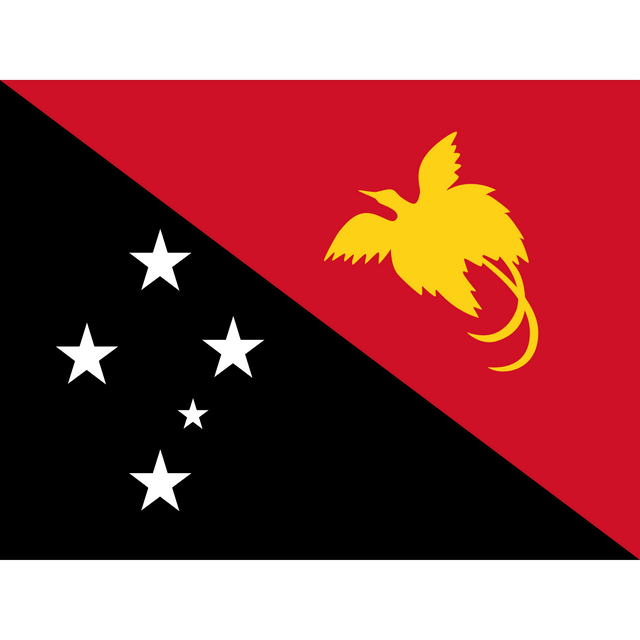
Papua New Guinea

| Capital | Port Moresby |
|---|---|
| Official languages[3][4] | |
| 851 languages[5] | |
| Ethnic groups | |
| Demonym(s) | Papua New Guinean |
| Government | |
| Elizabeth II | |
| Bob Dadae | |
| James Marape | |
| Legislature | National Parliament |
| Independence | |
| 1 July 1949 | |
| 16 September 1975 | |
| Area | |
| 462,840 km(178,700 sq mi) (54th) | |
| 2 | |
| Population | |
| 8,084,999[6](101st) | |
| 5,190,783 | |
| 15/km(38.8/sq mi) (201st) | |
| GDP | 2019 estimate |
| $32.382 billion[7](124th) | |
| $3,764[7] | |
| GDP | 2019 estimate |
| $21.543 billion[7](110th) | |
| $2,504[7] | |
| Gini | 41.9[8] |
| HDI | |
| Currency | Papua New Guinean kina(PGK) |
| Time zone | (AEST) |
| Driving side | left |
| Calling code | +675 |
| ISO 3166 code | PG |
| Internet TLD | .pg |
Papua New Guinea (PNG; /ˈpæp(j)uə ... ˈɡɪni, ˈpɑː-/, also US: /ˈpɑːpwə-, ˈpɑːpjə-, ˈpɑːpə-/;[10] Tok Pisin: Papua Niugini; Hiri Motu: Papua Niu Gini), officially the Independent State of Papua New Guinea (Tok Pisin: Independen Stet bilong Papua Niugini; Hiri Motu: Independen Stet bilong Papua Niu Gini) is a country in Oceania that occupies the eastern half of the island of New Guinea and its offshore islands in Melanesia, a region of the southwestern Pacific Ocean north of Australia. Its capital, located along its southeastern coast, is Port Moresby. The western half of New Guinea forms the Indonesian provinces of Papua and West Papua. It is the world's 3rd largest island country with 462,840 km2 (178,700 sq mi).[11]
At the national level, after being ruled by three external powers since 1884, Papua New Guinea established its sovereignty in 1975.
This followed nearly 60 years of Australian administration, which started during World War I. It became an independent Commonwealth realm in 1975 with Elizabeth II as its queen. It also became a member of the Commonwealth of Nations in its own right.
Papua New Guinea is one of the most culturally diverse countries in the world. It is also one of the most rural, as only 18 per cent of its people live in urban centres.[12] There are 851 known languages in the country, of which 11 now have no known speakers.[5] Most of the population of more than 8 million people lives in customary communities, which are as diverse as the languages.[13] The country is one of the world's least explored, culturally and geographically. It is known to have numerous groups of uncontacted peoples, and researchers believe there are many undiscovered species of plants and animals in the interior.[14]
Papua New Guinea is classified as a developing economy by the International Monetary Fund.[15] Strong growth in Papua New Guinea's mining and resource sector led to the country becoming the sixth-fastest-growing economy in the world in 2011.[16] Growth was expected to slow once major resource projects came on line in 2015.[17] Mining remains a major economic factor, however. Local and national governments are discussing the potential of resuming mining operations at the Panguna mine in Bougainville Province, which has been closed since the civil war in the 1980s–1990s.[18] Nearly 40 per cent of the population lives a self-sustainable natural lifestyle with no access to global capital.[19]
Most of the people still live in strong traditional social groups based on farming. Their social lives combine traditional religion with modern practices, including primary education.[13] These societies and clans are explicitly acknowledged by the Papua New Guinea Constitution, which expresses the wish for "traditional villages and communities to remain as viable units of Papua New Guinean society"[20] and protects their continuing importance to local and national community life. The nation is an observer state in the Association of Southeast Asian Nations or ASEAN since 1976, and has already filed its application for full membership status.[21] It is a full member of the Pacific Islands Forum (formerly South Pacific Forum)[22] and the Commonwealth of Nations.[23]
| Capital | Port Moresby |
|---|---|
| Official languages[3][4] | |
| 851 languages[5] | |
| Ethnic groups | |
| Demonym(s) | Papua New Guinean |
| Government | |
| Elizabeth II | |
| Bob Dadae | |
| James Marape | |
| Legislature | National Parliament |
| Independence | |
| 1 July 1949 | |
| 16 September 1975 | |
| Area | |
| 462,840 km(178,700 sq mi) (54th) | |
| 2 | |
| Population | |
| 8,084,999[6](101st) | |
| 5,190,783 | |
| 15/km(38.8/sq mi) (201st) | |
| GDP | 2019 estimate |
| $32.382 billion[7](124th) | |
| $3,764[7] | |
| GDP | 2019 estimate |
| $21.543 billion[7](110th) | |
| $2,504[7] | |
| Gini | 41.9[8] |
| HDI | |
| Currency | Papua New Guinean kina(PGK) |
| Time zone | (AEST) |
| Driving side | left |
| Calling code | +675 |
| ISO 3166 code | PG |
| Internet TLD | .pg |
History
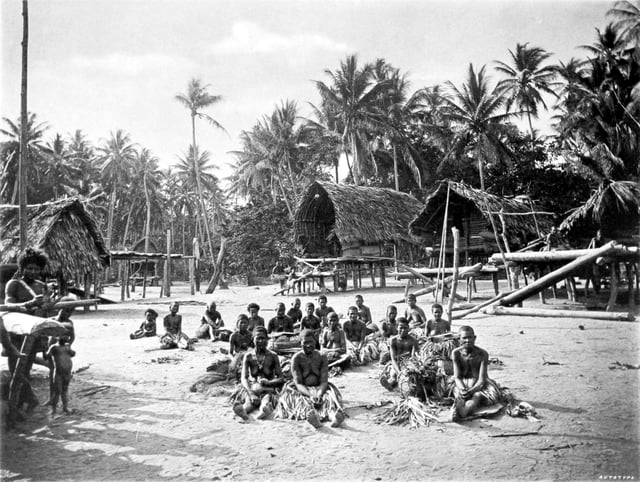
Kerepunu women at the marketplace of Kalo, British New Guinea, 1885
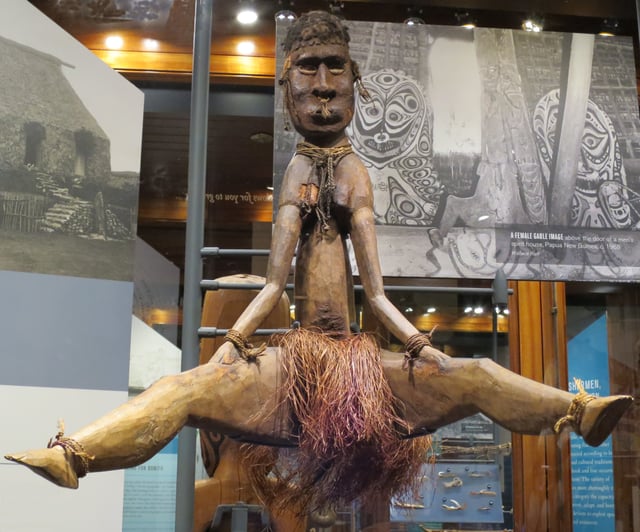
Female gable image, Sawos people, Oceanic art in the Bishop Museum.
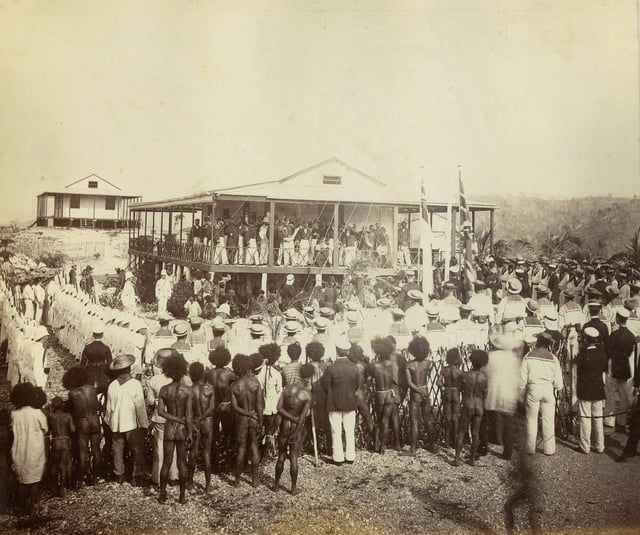
British annexation of southeast New Guinea in 1884

New Guinea from 1884 to 1919.
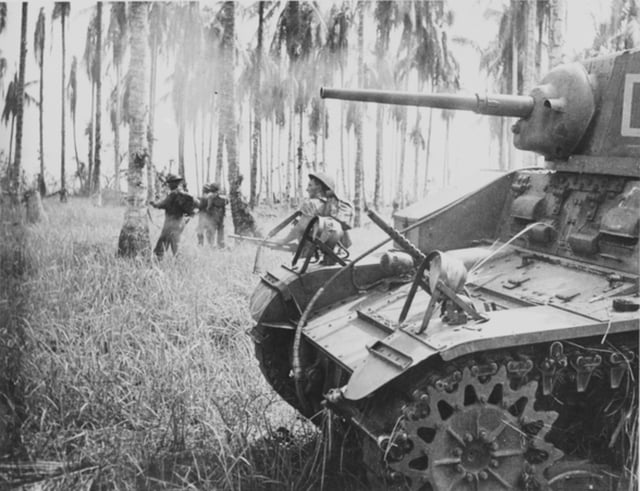
Australian forces attack Japanese positions during the Battle of Buna–Gona, 7 January 1943.
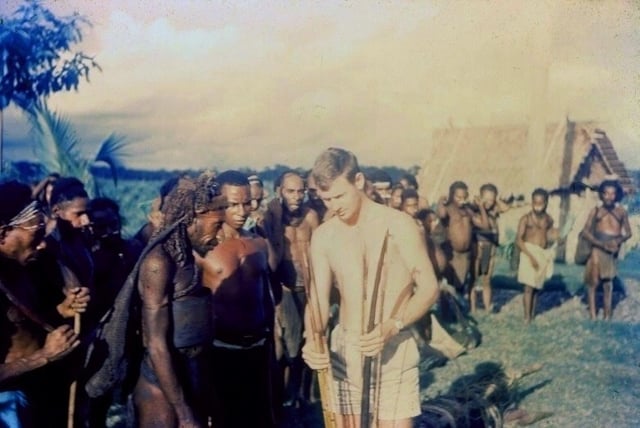
Australian patrol officer in 1964
Archaeological evidence indicates that humans first arrived in Papua New Guinea around 42,000 to 45,000 years ago.
They were descendants of migrants out of Africa, in one of the early waves of human migration.[24]
Agriculture was independently developed in the New Guinea highlands around 7000 BC, making it one of the few areas in the world where people independently domesticated plants.[25] A major migration of Austronesian-speaking peoples to coastal regions of New Guinea took place around 500 BC. This has been correlated with the introduction of pottery, pigs, and certain fishing techniques.
In the 18th century, traders brought the sweet potato to New Guinea, where it was adopted and became part of the staples. Portuguese traders had obtained it from South America and introduced it to the Moluccas.[26] The far higher crop yields from sweet potato gardens radically transformed traditional agriculture and societies. Sweet potato largely supplanted the previous staple, taro, and resulted in a significant increase in population in the highlands.
Although by the late 20th century headhunting and cannibalism had been practically eradicated, in the past they were practised in many parts of the country as part of rituals related to warfare and taking in enemy spirits or powers.[27][28] In 1901, on Goaribari Island in the Gulf of Papua, missionary Harry Dauncey found 10,000 skulls in the island's long houses, a demonstration of past practices.[29] According to Marianna Torgovnick, writing in 1991, "The most fully documented instances of cannibalism as a social institution come from New Guinea, where head-hunting and ritual cannibalism survived, in certain isolated areas, into the Fifties, Sixties, and Seventies, and still leave traces within certain social groups."[30]
Little was known in Europe about the island until the 19th century, although Portuguese and Spanish explorers, such as Dom Jorge de Menezes and Yñigo Ortiz de Retez, had encountered it as early as the 16th century. Traders from Southeast Asia had visited New Guinea beginning 5,000 years ago to collect bird-of-paradise plumes.[31]
The country's dual name results from its complex administrative history before independence.
The word papua is derived from an old local term of uncertain origin.[32] "New Guinea" (Nueva Guinea) was the name coined by the Spanish explorer Yñigo Ortiz de Retez. In 1545, he noted the resemblance of the people to those he had earlier seen along the Guinea coast of Africa. Guinea, in its turn, is etymologically derived from the Portuguese word Guiné. The name is one of several toponyms sharing similar etymologies, ultimately meaning "land of the blacks" or similar meanings, in reference to the dark skin of the inhabitants.
In the nineteenth century, Germany ruled the northern half of the country for some decades, beginning in 1884, as a colony named German New Guinea. In 1914 after the outbreak of World War I, Australian forces landed and captured German New Guinea in a small military campaign and occupied it throughout the war. After the war, in which Germany and the Central Powers were defeated, the League of Nations authorised Australia to administer this area as a League of Nations mandate territory.
The southern half of the country had been colonised in 1884 by the United Kingdom as British New Guinea. With the Papua Act 1905, the UK transferred this territory to the newly formed Commonwealth of Australia, which took on its administration. Additionally, from 1905, British New Guinea was renamed as the Territory of Papua. In contrast to establishing an Australian mandate in former German New Guinea, the League of Nations determined that Papua was an External Territory of the Australian Commonwealth; as a matter of law it remained a British possession. The difference in legal status meant that until 1949, Papua and New Guinea had entirely separate administrations, both controlled by Australia. These conditions contributed to the complexity of organising the country's post-independence legal system.
During World War II, the New Guinea campaign (1942–1945) was one of the major military campaigns and conflicts between Japan and the Allies. Approximately 216,000 Japanese, Australian, and US servicemen died.[33] After World War II and the victory of the Allies, the two territories were combined into the Territory of Papua and New Guinea. This was later referred to as "Papua New Guinea".
The natives of Papua appealed to the United Nations for oversight and independence.
The nation established independence from Australia on 16 September 1975, becoming a Commonwealth realm, continuing to share Queen Elizabeth II as its head of state. It maintains close ties with Australia, which continues to be its largest aid donor. Papua New Guinea was admitted to membership in the United Nations on 10 October 1975.[34]
A secessionist revolt in 1975–76 on Bougainville Island resulted in an eleventh-hour modification of the draft Constitution of Papua New Guinea to allow for Bougainville and the other eighteen districts to have quasi-federal status as provinces. A renewed uprising on Bougainville started in 1988 and claimed 20,000 lives until it was resolved in 1997. Bougainville had been the primary mining region of the country, generating 40% of the national budget. The native peoples felt they were bearing the adverse environmental effects of the mining, which poisoned the land, water and air, without gaining a fair share of the profits.[35]
The government and rebels negotiated a peace agreement that established the Bougainville Autonomous District and Province.
The autonomous Bougainville elected Joseph Kabui as president in 2005, who served until his death in 2008. He was succeeded by his deputy John Tabinaman as acting president while an election to fill the unexpired term was organised. James Tanis won that election in December 2008 and served until the inauguration of John Momis, the winner of the 2010 elections. As part of the current peace settlement, a referendum on independence is planned to be held in Bougainville sometime before mid-2020. Preparations were underway in 2015.[36][37]
Numerous Chinese have worked and lived in Papua New Guinea, establishing Chinese-majority communities.
Chinese merchants became established in the islands before European exploration.
Anti-Chinese rioting involving tens of thousands of people broke out in May 2009. The initial spark was a fight between ethnic Chinese and indigenous workers at a nickel factory under construction by a Chinese company. Native resentment against Chinese ownership of numerous small businesses and their commercial monopoly in the islands led to the rioting. The Chinese have long been merchants in Papua New Guinea.[38][39] In the same year, Papua New Guinea asked various Southeast Asian nations for their support for Papua New Guinea's full membership bid in the Association of Southeast Asian Nations (ASEAN). Indonesia supported the bid after Papua New Guinea supported Indonesia's hold on West Papua. However, the Philippines, Thailand, Vietnam, and Cambodia have expressed displeasure over Papua New Guinea's anti-LGBT laws, stating that equality-friendly Timor-Leste would most likely be a more feasible ASEAN member state in the future.[40][41]
From March to April 2018, a chain of earthquakes hit Papua New Guinea, causing various damage. Various nations from Oceania, Australia, the Philippines and Timor-Leste immediately sent aid to the country.[42][43]
The referendum on Bougainville's independence will be held on 17 October 2019.[44]
Government and politics
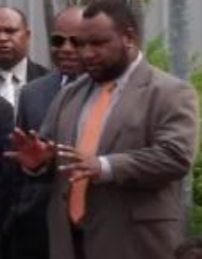
Prime Minister James Marape.
Papua New Guinea is a Commonwealth realm with Elizabeth II as Queen of Papua New Guinea. The constitutional convention, which prepared the draft constitution, and Australia, the outgoing metropolitan power, had thought that Papua New Guinea would not remain a monarchy. The founders, however, considered that imperial honours had a cachet.[45] The monarch is represented by the Governor-General of Papua New Guinea, currently Bob Dadae. Papua New Guinea (and the Solomon Islands) are unusual among Commonwealth realms in that governors-general are elected by the legislature, rather than chosen by the executive branch.
The Prime Minister heads the cabinet, which consists of 31 MPs from the ruling coalition, which make up the government. The current prime minister is James Marape. The unicameral National Parliament has 111 seats, of which 22 are occupied by the governors of the 22 provinces and the National Capital District (NCD). Candidates for members of parliament are voted upon when the prime minister asks the governor-general to call a national election, a maximum of five years after the previous national election.
In the early years of independence, the instability of the party system led to frequent votes of no confidence in parliament, with resulting changes of the government, but with referral to the electorate, through national elections only occurring every five years. In recent years, successive governments have passed legislation preventing such votes sooner than 18 months after a national election and within 12 months of the next election. In December 2012, the first two (of three) readings were passed to prevent votes of no confidence occurring within the first 30 months. This restriction on votes of no confidence has arguably resulted in greater stability, although perhaps at a cost of reducing the accountability of the executive branch of government.
Elections in PNG attract numerous candidates.
After independence in 1975, members were elected by the first-past-the-post system, with winners frequently gaining less than 15% of the vote. Electoral reforms in 2001 introduced the Limited Preferential Vote system (LPV), a version of the Alternative Vote. The 2007 general election was the first to be conducted using LPV.
In 2011 there was a constitutional crisis between the parliament-elect Prime Minister, Peter O'Neill (voted into office by a large majority of MPs), and Sir Michael Somare, who was deemed by the supreme court (in a December Opinion, 3:2) to retain office. The stand-off between parliament and the supreme court continued until the July 2012 national elections, with legislation passed effectively removing the chief justice and subjecting the supreme court members to greater control by the legislature, as well as a series of other laws passed, for example limiting the age for a prime minister. The confrontation reached a peak, with the Deputy Prime Minister entering the supreme court during a hearing, escorted by some police, ostensibly to arrest the Chief Justice. There was strong pressure among some MPs to defer the national elections for a further six months to one year, although their powers to do that were highly questionable.
The parliament-elect prime minister and other cooler-headed MPs carried the votes for the writs for the new election to be issued, slightly late, but for the election itself to occur on time, thereby avoiding a continuation of the constitutional crisis.
The crisis was tense at times, but largely restricted to the political and legal fraternity, plus some police factions.
The public and public service (including most police and military) stood back.
It was a period when, with increased telecommunication access and use of social media (notably Facebook and mobile phones), the public and students played some part in helping maintain restraint and demanding the leadership to adhere to constitutional processes.
They insisted on having the elections so that the people could say who should be their legitimate representatives for the next five years.
Under a 2002 amendment, the leader of the party winning the largest number of seats in the election is invited by the governor-general to form the government, if he can muster the necessary majority in parliament.
The process of forming such a coalition in PNG, where parties do not have much ideology, involves considerable horsetrading right up until the last moment.
Peter O'Neill emerged as Papua New Guinea's prime minister after the July 2012 election, and formed a government with Leo Dion, the former Governor of East New Britain Province, as deputy prime minister.
Law

The Parliament building of Papua New Guinea in Port Moresby
The unicameral Parliament enacts legislation in the same manner as in other commonwealth realms that use the Westminster system of government.
The cabinet collectively agree government policy then the relevant minister introduces bills to Parliament depending on which government department is responsible for implementation of a particular law.
Back bench members of parliament can also introduce bills.
Parliament debates bills and if approved the bill is forwarded to the Governor-General for Royal assent, following which it becomes law.
All ordinary statutes enacted by Parliament must be consistent with the Constitution.
The courts have jurisdiction to rule on the constitutionality of statutes, both in disputes before them and on a reference where there is no dispute but only an abstract question of law.
Unusual among developing countries, the judicial branch of government in Papua New Guinea has remained remarkably independent, and successive executive governments have continued to respect its authority.
The "underlying law" (Papua New Guinea's common law) consists of principles and rules of common law and equity in English[46] common law as it stood on 16 September 1975 (the date of Independence), and thereafter the decisions of PNG's own courts. The courts are directed by the Constitution and, latterly, the Underlying Law Act, to take note of the "custom" of traditional communities. They are to determine which customs are common to the whole country and may be declared also to be part of the underlying law. In practice, this has proved extremely difficult and has been largely neglected. Statutes are largely adapted from overseas jurisdictions, primarily Australia and England. Advocacy in the courts follows the adversarial pattern of other common-law countries.
This national court system, used in towns and cities, is supported by a village court system in the more remote areas.
The law underpinning the village courts is 'customary law'.
Foreign policy
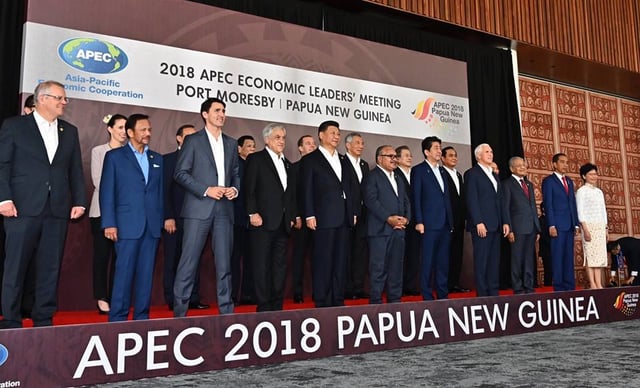
APEC 2018 in Papua New Guinea
In foreign policy, Papua New Guinea is a member of the Commonwealth of Nations, Pacific Islands Forum, and the Melanesian Spearhead Group (MSG) of countries. It was accorded Observer status within ASEAN in 1976, followed later by Special Observer status in 1981. It is also a member of APEC and an ACP country, associated with the European Union.
Papua New Guinea supported Indonesia's control of Western New Guinea:[47] the focus of the Papua conflict where numerous human rights violations have reportedly been committed by the Indonesian security forces.[48][49] In September 2017, Papua New Guinea rejected the West Papuan Independence Petition in the UN General Assembly.[50]
Military
The Papua New Guinea Defence Force (PNGDF) is the military organisation responsible for the defence of Papua New Guinea.
Human rights
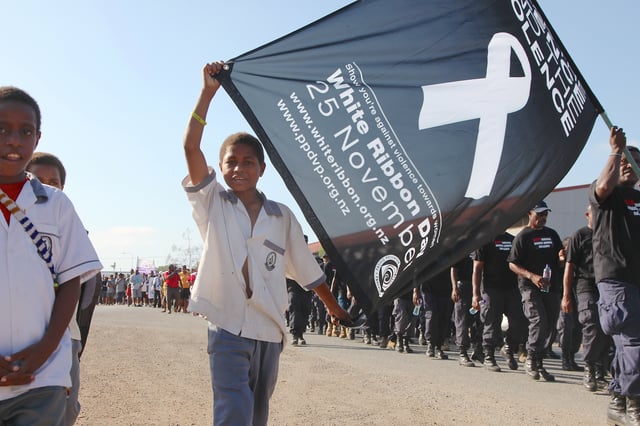
Papua New Guinean children, men and women show their support for putting an end to violence against women during a White Ribbon Day march
Papua New Guinea is often ranked as likely the worst place in the world for violence against women.[51][52] A 2013 study in The Lancet found that 27% of men on Bougainville Island, Papua New Guinea, reported having raped a non-partner, while 14.1% reported having committed gang rape.[53] According to UNICEF, nearly half of reported rape victims are under 15 years of age and 13% are under 7 years of age.[54] A report by ChildFund Australia, citing former Parliamentarian Dame Carol Kidu, claimed 50% of those seeking medical help after rape are under 16, 25% are under 12, and 10% are under 8.[55]
The 1976 Sorcery Act imposed a penalty of up to 2 years in prison for the practice of "black" magic, until the Act was repealed in 2013.[56] An estimated 50–150 alleged witches are killed each year in Papua New Guinea.[57] There are also no protections given to LGBT citizens in the country. Homosexual acts are prohibited by law in Papua New Guinea.[58]
Administrative divisions
Papua New Guinea is divided into four regions, which are not the primary administrative divisions but are quite significant in many aspects of government, commercial, sporting and other activities.
The nation has 22 province-level divisions: twenty provinces, the Autonomous Region of Bougainville and the National Capital District. Each province is divided into one or more districts, which in turn are divided into one or more Local-Level Government areas.
Provinces[59] are the primary administrative divisions of the country.
Provincial governments are branches of the national government as Papua New Guinea is not a federation of provinces.
The province-level divisions are as follows:
|
|
In 2009, Parliament approved the creation of two additional provinces: Hela Province, consisting of part of the existing Southern Highlands Province, and Jiwaka Province, formed by dividing Western Highlands Province.[60] Jiwaka and Hela officially became separate provinces on 17 May 2012.[61] The declaration of Hela and Jiwaka is a result of the largest liquefied natural gas (LNG)[62] project in the country that is situated in both provinces. The government set 23 November 2019[63] as the voting date for a non-binding[64] independence referendum in the Bougainville autonomous region.[65] The Australian Strategic Policy Institute has said that there is a wide expectation Bougainville will vote to become independent.[66]
Geography
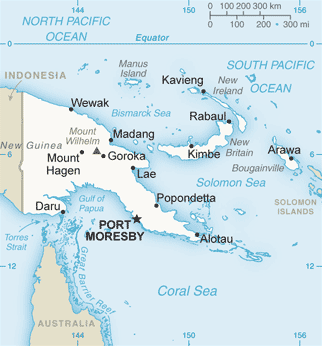
Map of Papua New Guinea
At 462,840 km2 (178,704 sq mi), Papua New Guinea is the world's 54th largest country and the 3rd largest island country.[11] Including all its islands, it lies between latitudes 0° and 12°S, and longitudes 140° and 160°E. It has an exclusive economic zone of 2,402,288 km2 (927,529 sq mi).
Located north of the Australian mainland, the country's geography is diverse and, in places, extremely rugged.
A spine of mountains, the New Guinea Highlands, runs the length of the island of New Guinea, forming a populous highlands region mostly covered with tropical rainforest, and the long Papuan Peninsula, known as the 'Bird's Tail'. Dense rainforests can be found in the lowland and coastal areas as well as very large wetland areas surrounding the Sepik and Fly rivers. This terrain has made it difficult for the country to develop transportation infrastructure. Some areas are accessible only on foot or by aeroplane. The highest peak is Mount Wilhelm at 4,509 metres (14,793 ft). Papua New Guinea is surrounded by coral reefs which are under close watch, in the interests of preservation.
The country is situated on the Pacific Ring of Fire, at the point of collision of several tectonic plates. There are a number of active volcanoes, and eruptions are frequent. Earthquakes are relatively common, sometimes accompanied by tsunamis.
The mainland of the country is the eastern half of New Guinea island, where the largest towns are also located, including Port Moresby (capital) and Lae; other major islands within Papua New Guinea include New Ireland, New Britain, Manus and Bougainville.
Papua New Guinea is one of the few regions close to the equator that experience snowfall, which occurs in the most elevated parts of the mainland.
Borders
The border between Papua New Guinea and Indonesia was confirmed by treaty with Australia before independence in 1974.[67] The land border comprises a segment of the 141° E meridian from the north coast southwards to where it meets the Fly River flowing east, then a short curve of the river's thalweg to where it meets the 141°01'10" E meridian flowing west, then southwards to the south coast.[67] The 141° E meridian formed the entire eastern boundary of Dutch New Guinea according to its 1828 annexation proclamation.[68] In 1895 the Dutch and British agreed to a territorial exchange, bringing the entire left bank of the Fly River into British New Guinea and moving the southern border east to the Torasi Estuary.[68]
The maritime boundary with Australia was confirmed by a treaty in 1978.[69] In the Torres Strait it runs close to the mainland of New Guinea, keeping the adjacent North Western Torres Strait Islands (Dauan, Boigu and Saibai) under Australian sovereignty. Maritime boundaries with the Solomon Islands were confirmed by a 1989 treaty.
Ecology
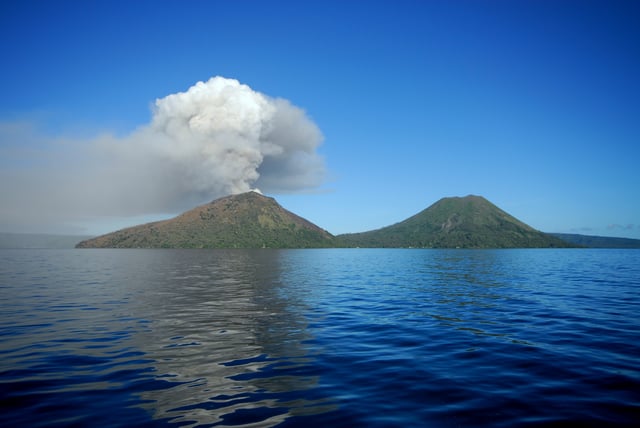
Mount Tavurvur
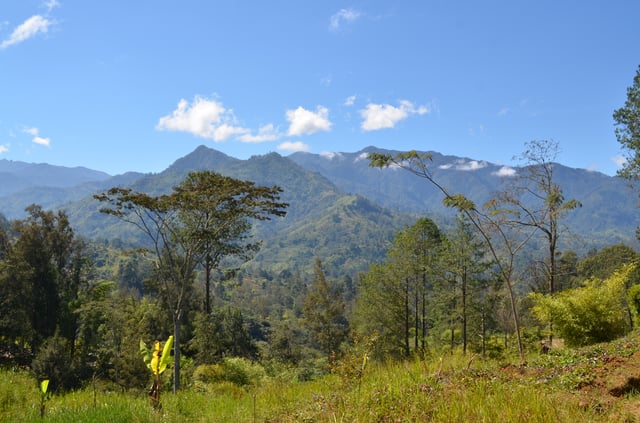
Papua New Guinea's highlands
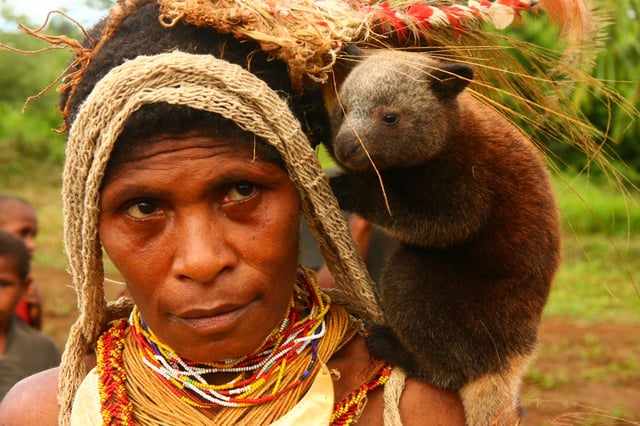
A tree-kangaroo in Papua New Guinea
Papua New Guinea is part of the Australasia ecozone, which also includes Australia, New Zealand, eastern Indonesia, and several Pacific island groups, including the Solomon Islands and Vanuatu.
Geologically, the island of New Guinea is a northern extension of the Indo-Australian tectonic plate, forming part of a single land mass which is Australia-New Guinea (also called Sahul or Meganesia). It is connected to the Australian segment by a shallow continental shelf across the Torres Strait, which in former ages lay exposed as a land bridge, particularly during ice ages when sea levels were lower than at present.
Consequently, many species of birds and mammals found on New Guinea have close genetic links with corresponding species found in Australia.
One notable feature in common for the two landmasses is the existence of several species of marsupial mammals, including some kangaroos and possums, which are not found elsewhere. Papua New Guinea is a megadiverse country.
Many of the other islands within PNG territory, including New Britain, New Ireland, Bougainville, the Admiralty Islands, the Trobriand Islands, and the Louisiade Archipelago, were never linked to New Guinea by land bridges. As a consequence, they have their own flora and fauna; in particular, they lack many of the land mammals and flightless birds that are common to New Guinea and Australia.
Australia and New Guinea are portions of the ancient supercontinent of Gondwana, which started to break into smaller continents in the Cretaceous period, 65–130 million years ago. Australia finally broke free from Antarctica about 45 million years ago. All the Australasian lands are home to the Antarctic flora, descended from the flora of southern Gondwana, including the coniferous podocarps and Araucaria pines, and the broadleafed southern beech (Nothofagus
As the Indo-Australian Plate (which includes landmasses of India, Australia, and the Indian Ocean floor in between) drifts north, it collides with the Eurasian Plate. The collision of the two plates pushed up the Himalayas, the Indonesian islands, and New Guinea's Central Range. The Central Range is much younger and higher than the mountains of Australia, so high that it is home to rare equatorial glaciers. New Guinea is part of the humid tropics, and many Indomalayan rainforest plants spread across the narrow straits from Asia, mixing together with the old Australian and Antarctic floras.
PNG includes a number of terrestrial ecoregions:
Admiralty Islands lowland rain forests – forested islands to the north of the mainland, home to a distinct flora.
Central Range montane rain forests Green tropical rainforest of Papua New Guinea bears a sharp contrast to nearby arid Australia.
Huon Peninsula montane rain forests
Louisiade Archipelago rain forests
New Britain-New Ireland lowland rain forests
New Britain-New Ireland montane rain forests
New Guinea mangroves
Northern New Guinea lowland rain and freshwater swamp forests
Northern New Guinea montane rain forests
Solomon Islands rain forests (includes Bougainville Island and Buka)
Southeastern Papuan rain forests
Southern New Guinea freshwater swamp forests
Southern New Guinea lowland rain forests
Trobriand Islands rain forests
Trans-Fly savanna and grasslands
Central Range sub-alpine grasslands
Three new species of mammals were discovered in the forests of Papua New Guinea by an Australian-led expedition.
A small wallaby, a large-eared mouse and shrew-like marsupial were discovered.
The expedition was also successful in capturing photographs and video footage of some other rare animals such as the Tenkile tree kangaroo and the Weimang tree kangaroo.[70]
Environmental issues
2018 earthquake
Economy

Port Moresby's central business district
Papua New Guinea is richly endowed with natural resources, including mineral and renewable resources, such as forests, marine (including a large portion of the world's major tuna stocks), and in some parts agriculture.
The rugged terrain—including high mountain ranges and valleys, swamps and islands—and high cost of developing infrastructure, combined with other factors (including serious law and order problems in some centres and the system of customary land title) makes it difficult for outside developers.
Local developers are handicapped by years of deficient investment in education, health, ICT and access to finance.
Agriculture, for subsistence and cash crops, provides a livelihood for 85% of the population and continues to provide some 30% of GDP.
Mineral deposits, including gold, oil, and copper, account for 72% of export earnings. Oil palm production has grown steadily over recent years (largely from estates and with extensive outgrower output), with palm oil now the main agricultural export. In households participating, coffee remains the major export crop (produced largely in the Highlands provinces), followed by cocoa and coconut oil/copra from the coastal areas, each largely produced by smallholders and tea, produced on estates and rubber. The Iagifu/Hedinia Field was discovered in 1986 in the Papuan fold and thrust belt.[75]
Former Prime Minister Sir Mekere Morauta tried to restore integrity to state institutions, stabilise the kina, restore stability to the national budget, privatise public enterprises where appropriate, and ensure ongoing peace on Bougainville following the 1997 agreement which ended Bougainville's secessionist unrest. The Morauta government had considerable success in attracting international support, specifically gaining the backing of the International Monetary Fund (IMF) and the World Bank in securing development assistance loans. Significant challenges face Prime Minister Sir Michael Somare, including gaining further investor confidence, continuing efforts to privatise government assets, and maintaining the support of members of Parliament.
In March 2006, the United Nations Development Programme Policy called for Papua New Guinea's designation of developing country to be downgraded to least-developed country because of protracted economic and social stagnation.[76] However, an evaluation by the IMF in late 2008 found that "a combination of prudent fiscal and monetary policies, and high global prices for mineral commodity exports, have underpinned Papua New Guinea's recent buoyant economic growth and macroeconomic stability. By 2012 PNG had enjoyed a decade of positive economic growth, at over 6% since 2007, even during the Global Financial Crisis years of 2008/9. PNG's Real GDP growth rate as at 2011 was 8.9%,"[undefined] and 9.2% for 2012, according to the Asian Development Bank.[78] As of 2019, PNG's real GDP growth rate has dropped to 3.8%, along with an inflation rate of 4.3%[79]
This economic growth has been primarily attributed to strong commodity prices, particularly mineral but also agricultural, with the high demand for mineral products largely sustained even during the crisis by the buoyant Asian markets, a booming mining sector, and particularly since 2009 by a buoyant outlook and the construction phase for natural gas exploration, production, and exportation in liquefied form (liquefied natural gas or "LNG") by LNG tankers (LNG carrier), all of which will require multibillion-dollar investments (exploration, production wells, pipelines, storage, liquefaction plants, port terminals, LNG tanker ships).
The first major gas project was the PNG LNG joint venture.
ExxonMobil is operator of the joint venture, also comprising PNG company Oil Search, Santos, Kumul Petroleum Holdings (Papua New Guinea's national oil and gas company), JX Nippon Oil and Gas Exploration, the PNG government's Mineral Resources Development Company and Petromin PNG Holdings.[80] The project is an integrated development that includes gas production and processing facilities in the Hela, Southern Highlands and Western Provinces of Papua New Guinea, including liquefaction and storage facilities (located northwest of Port Moresby) with capacity of 6.9 million tonnes per year. There are over 700 kilometres (430 mi) of pipelines connecting the facilities.[80] It is the largest private-sector investment in the history of PNG.[81]
A second major project is based on initial rights held by the French oil and gas major Total S.A. and the US company InterOil Corp. (IOC), which have partly combined their assets after Total agreed in December 2013 to purchase 61.3% of IOC's Antelope and Elk gas field rights, with the plan to develop them starting in 2016, including the construction of a liquefaction plant to allow export of LNG. Total S.A. has separately another joint operating agreement with Oil Search.
Further gas and mineral projects are proposed (including the large Wafi-Golpu copper-gold mine), with extensive exploration ongoing across the country.[82]
Economic 'development' based on the extractive industries carries difficult consequences for local communities.
There has been much contention around river tailings in the vast Fly River, submarine tailings from the new Ramu-Nickel-cobalt mine, commencing exports in late 2012 (after a delay from landowner-led court challenges), and from proposed submarine mining in the Bismarck Sea (by Nautilus Minerals). One major project conducted through the PNG Department for Community Development suggested that other pathways to sustainable development should be considered.[83]
The PNG government's long-term Vision 2050 and shorter-term policy documents, including the 2013 Budget and the 2014 Responsible Sustainable Development Strategy, emphasise the need for a more diverse economy, based upon sustainable industries and avoiding the effects of Dutch disease from major resource extraction projects undermining other industries, as has occurred in many countries experiencing oil or other mineral booms, notably in Western Africa, undermining much of their agriculture sector, manufacturing and tourism, and with them broad-based employment prospects. Measures have been taken to mitigate these effects, including through the establishment of a sovereign wealth fund, partly to stabilise revenue and expenditure flows, but much will depend upon the readiness to make real reforms to effective use of revenue, tackling rampant corruption and empowering households and businesses to access markets, services and develop a more buoyant economy, with lower costs, especially for small to medium-size enterprises.
The Institute of National Affairs, a PNG independent policy think tank, provides a report on the business and investment environment of Papua New Guinea every five years, based upon a survey of large and small, local and overseas companies, highlighting law and order problems and corruption, as the worst impediments, followed by the poor state of transport, power and communications infrastructure.[84]
Land tenure
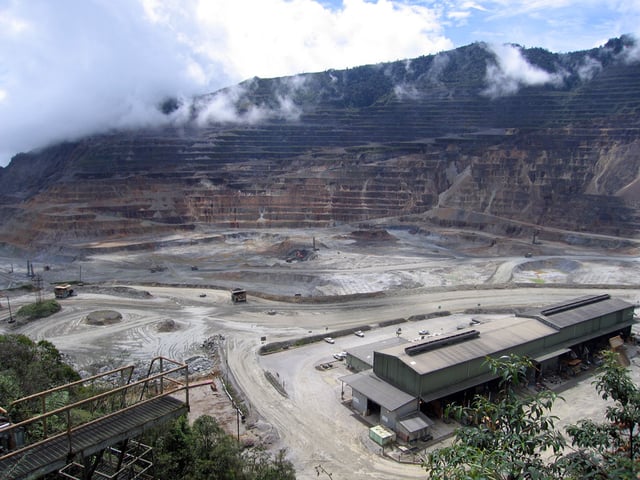
The Ok Tedi Mine in southwestern Papua New Guinea
The PNG legislature has enacted laws in which a type of tenure called "customary land title" is recognised, meaning that the traditional lands of the indigenous peoples have some legal basis to inalienable tenure. This customary land notionally covers most of the usable land in the country (some 97% of total land area);[85] alienated land is either held privately under state lease or is government land. Freehold title (also known as fee simple) can only be held by Papua New Guinean citizens.[86]
Only some 3% of the land of Papua New Guinea is in private hands; this is privately held under 99-year state lease, or it is held by the State.
There is virtually no freehold title; the few existing freeholds are automatically converted to state lease when they are transferred between vendor and purchaser.
Unalienated land is owned under customary title by traditional landowners.
The precise nature of the seisin varies from one culture to another. Many writers portray land as in the communal ownership of traditional clans; however, closer studies usually show that the smallest portions of land whose ownership cannot be further divided are held by the individual heads of extended families and their descendants or their descendants alone if they have recently died.
This is a matter of vital importance because a problem of economic development is identifying the membership of customary landowning groups and the owners.
Disputes between mining and forestry companies and landowner groups often devolve on the issue of whether the companies entered into contractual relations for the use of land with the true owners.
Customary property—usually land—cannot be devised by will.
It can only be inherited according to the custom of the deceased's people.
The Lands Act was amended in 2010 along with the Land Group Incorporation Act, intended to improve the management of state land, mechanisms for dispute resolution over land, and to enable customary landowners to be better able to access finance and possible partnerships over portions of their land, if they seek to develop it for urban or rural economic activities.
The Land Group Incorporation Act requires more specific identification of the customary landowners than hitherto and their more specific authorisation before any land arrangements are determined; (a major issue in recent years has been a land grab, using, or rather misusing, the Lease-Leaseback provision under the Land Act, notably using 'Special Agricultural and Business Leases' (SABLs) to acquire vast tracts of customary land, purportedly for agricultural projects, but in an almost all cases as a back-door mechanism for securing tropical forest resources for logging—circumventing the more exacting requirements of the Forest Act, for securing Timber Permits (which must comply with sustainability requirements and be competitively secured, and with the customary landowners approval).
Following a national outcry, these SABLs have been subject to a Commission of Inquiry, established in mid-2011, for which the report is still awaited for initial presentation to the Prime Minister and Parliament.
Demographics
| Population[87] | |||
|---|---|---|---|
| Year | Million | ||
| 1950 | 1.7 | ||
| 2000 | 5.6 | ||
| 2016 | 8.1 | ||
Papua New Guinea is one of the most heterogeneous nations in the world.[88] There are hundreds of ethnic groups indigenous to Papua New Guinea, the majority being from the group known as Papuans, whose ancestors arrived in the New Guinea region tens of thousands of years ago. The other indigenous peoples are Austronesians, their ancestors having arrived in the region less than four thousand years ago.
There are also numerous people from other parts of the world now resident, including Chinese,[89] Europeans, Australians, Indonesians, Filipinos, Polynesians, and Micronesians (the last four belonging to the Austronesian family). Around 40,000 expatriates, mostly from Australia and China, were living in Papua New Guinea in 1975.[90]
Urbanisation
According to the CIA World Factbook (2018)[2] [124], Papua New Guinea has the second lowest urban population percentage in the world, with 13.2%, only behind Burundi.
The geography and economy of Papua New Guinea are the main factors behind the low percentage. Papua New Guinea has an urbanisation rate of 2.51%, measured as the projected change in urban population from 2015 to 2020.
According to Statista (2017) [125], here are the urban population percentages in Papua New Guinea from 2007 to 2017: 13.07, 13.06, 13.04, 13.02, 13, 12.98, 12.98, 12.99, 13.01, 13.05 and 13.1.
Languages
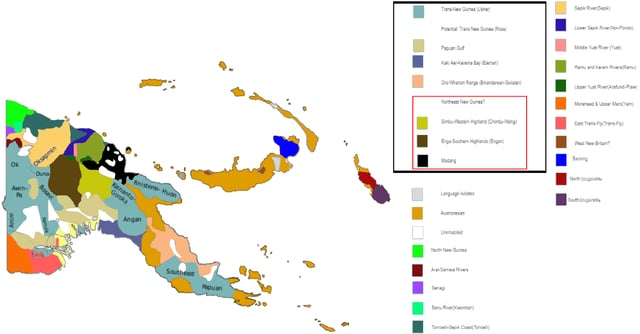
The language families of Papua New Guinea, according to Timothy Usher

The language families in Ross's conception of the Trans-New Guinea language family. The affiliation of some Eastern branches is not universally accepted.
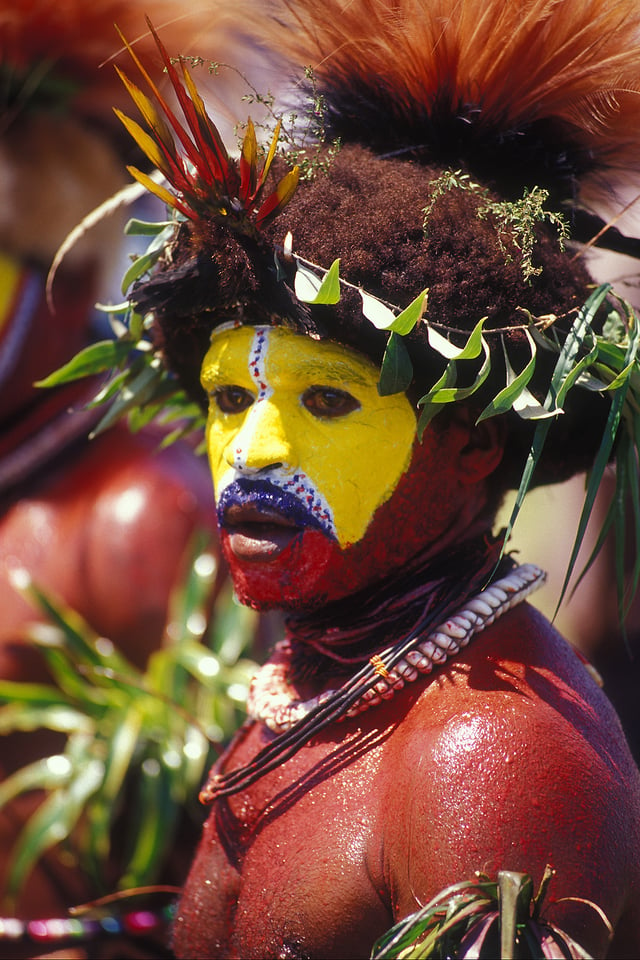
Huli wigman from the Southern Highlands
Papua New Guinea has more languages than any other country,[91] with over 820 indigenous languages, representing 12% of the world's total, but most have fewer than 1,000 speakers.
The most widely spoken indigenous language is Enga, with about 200,000 speakers, followed by Melpa and Huli.[92] Indigenous languages are classified into two large groups, Austronesian languages and non-Austronesian, or Papuan, languages. There are four official languages in Papua New Guinea: English, sign language (which in practice means Papua New Guinean Sign Language), Tok Pisin and Hiri Motu.
English is the language of government and the education system, but it is not spoken widely.
The primary lingua franca of the country is Tok Pisin (commonly known in English as New Guinean Pidgin or Melanesian Pidgin), in which much of the debate in Parliament is conducted, many information campaigns and advertisements are presented, and until recently a national newspaper, Wantok, was published. The only area where Tok Pisin is not prevalent is the southern region of Papua, where people often use the third official language, Hiri Motu.
Although it lies in the Papua region, Port Moresby has a highly diverse population which primarily uses Tok Pisin, and to a lesser extent English, with Motu spoken as the indigenous language in outlying villages.
With an average of only 7,000 speakers per language, Papua New Guinea has a greater density of languages than any other nation on earth except Vanuatu.[93]
Health
Religion
The government and judiciary uphold the constitutional right to freedom of speech, thought, and belief, and no legislation to curb those rights has been adopted.
The 2011 census found that 95.6% of citizens identified themselves as Christian, 1.4% were not Christian, and 3.1% gave no answer. Virtually no respondent identified as having nonreligious. Religious syncretism is high, with many citizens combining their Christian faith with some traditional indigenous religious practices.[95]
Most Christians in Papua New Guinea are Protestants, constituting roughly 70% of the total population. They are mostly represented by the Evangelical Lutheran Church of Papua New Guinea, the Seventh-day Adventist Church, diverse Pentecostal denominations, the United Church in Papua New Guinea and the Solomon Islands, the Evangelical Alliance Papua New Guinea, and the Anglican Church of Papua New Guinea. Apart from Protestants, there is a notable Roman Catholic minority with approximately 25% of the population.
There are approximately 2,000 Muslims in the country. The majority belong to the Sunni group, while a small number are Ahmadi. Non-traditional Christian churches and non-Christian religious groups are active throughout the country. The Papua New Guinea Council of Churches has stated that both Muslim and Confucian missionaries are highly active.[96][97]
Traditional religions are often animist. Some also tend to have elements of veneration of the dead, though generalisation is suspect given the extreme heterogeneity of Melanesian societies. Prevalent among traditional tribes is the belief in masalai, or evil spirits, which are blamed for "poisoning" people, causing calamity and death, and the practice of puripuri (sorcery).[98][99]
Culture
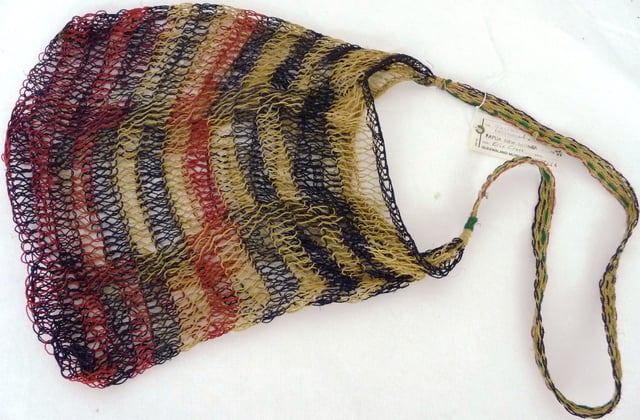
Bilum bag from Goroka, Eastern Highlands Province
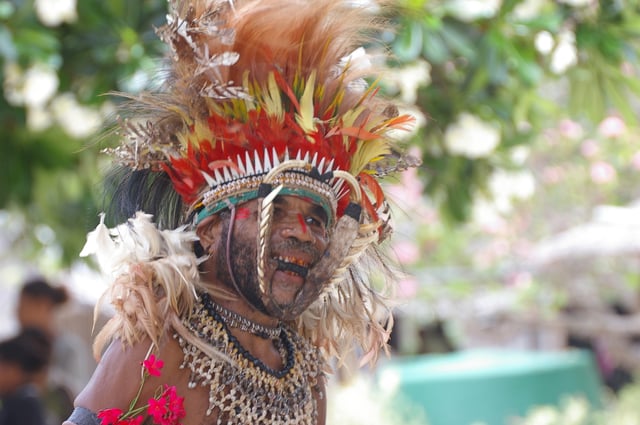
A resident of Boga-Boga, a village on the southeast coast of mainland Papua New Guinea
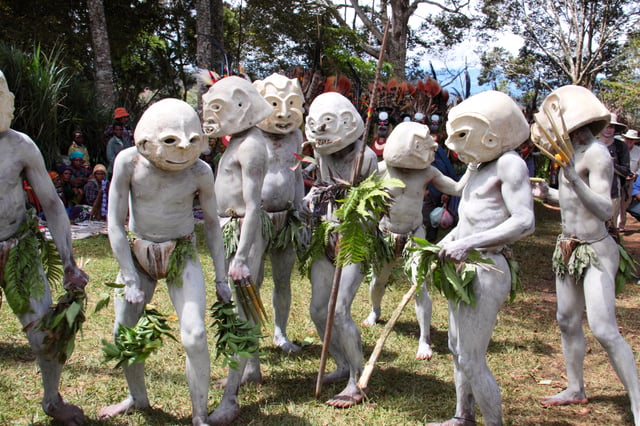
Asaro Mudmen
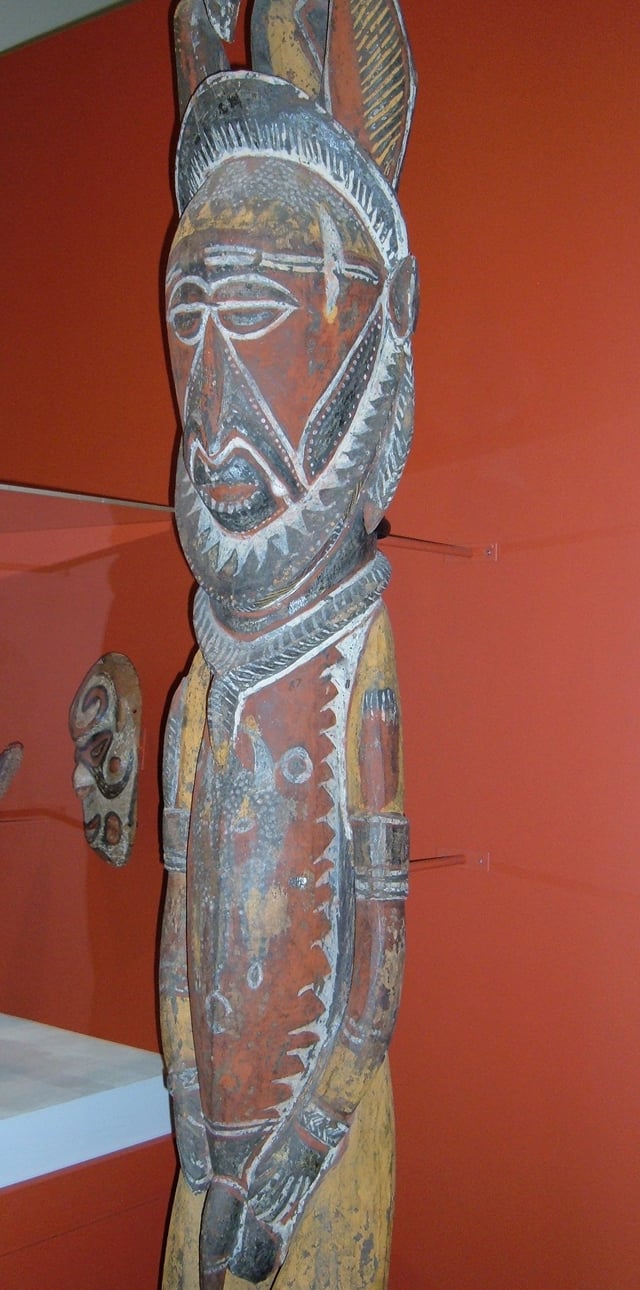
A 20th-century wooden Abelam ancestor figure (nggwalndu)
It is estimated that more than a thousand cultural groups exist in Papua New Guinea.
Because of this diversity, many styles of cultural expression have emerged.
Each group has created its own expressive forms in art, dance, weaponry, costumes, singing, music, architecture and much more.
Most of these cultural groups have their own language.
People typically live in villages that rely on subsistence farming.
In some areas people hunt and collect wild plants (such as yam roots and karuka) to supplement their diets. Those who become skilled at hunting, farming and fishing earn a great deal of respect.
On the Sepik river, there is a tradition of wood carving, often in the form of plants or animals, representing ancestor spirits.
Seashells are no longer the currency of Papua New Guinea, as they were in some regions—sea shells were abolished as currency in 1933. This tradition is still present in local customs. In some cultures, to get a bride, a groom must bring a certain number of golden-edged clam shells[100] as a bride price. In other regions, the bride price is paid in lengths of shell money, pigs, cassowaries or cash. Elsewhere, it is brides who traditionally pay a dowry.
People of the highlands engage in colourful local rituals that are called "sing sings".
They paint themselves and dress up with feathers, pearls and animal skins to represent birds, trees or mountain spirits. Sometimes an important event, such as a legendary battle, is enacted at such a musical festival.
The country possesses one (1) UNESCO World Heritage site, namely, Kuk Early Agricultural Site, which was inscribed in 2008. The country, however, has no elements inscribed yet in the UNESCO Intangible Cultural Heritage Lists, despite having one of the widest array of intangible cultural heritage elements in the world.[101][102]
Sport
Sport is an important part of Papua New Guinean culture and rugby league is by far the most popular sport.[103] In a nation where communities are far apart and many people live at a minimal subsistence level, rugby league has been described as a replacement for tribal warfare as a way of explaining the local enthusiasm for the game (a matter of life or death). Many Papua New Guineans have become instant celebrities by representing their country or playing in an overseas professional league. Even Australian rugby league players who have played in the annual State of Origin series, which is celebrated feverishly every year in PNG, are among the most well-known people throughout the nation.
State of Origin is a highlight of the year for most Papua New Guineans, although the support is so passionate that many people have died over the years in violent clashes supporting their team.[104] The Papua New Guinea national rugby league team usually plays against the Australian Prime Minister's XIII (a selection of NRL players) each year, normally in Port Moresby.
Although not as popular, Australian rules football is more significant in another way, as the national team is ranked second, only after Australia. Other major sports which have a part in the Papua New Guinea sporting landscape are association football, rugby union, basketball and, in eastern Papua, cricket.
The capital city, Port Moresby, hosted the Pacific Games in 2015.
Education
A large proportion of the population is illiterate,[105] with women predominating in this area.[105] Much of the education in PNG is provided by church institutions.[106] This includes 500 schools of the Evangelical Lutheran Church of Papua New Guinea.[107] Papua New Guinea has six universities apart from other major tertiary institutions. The two founding universities are the University of Papua New Guinea, based in the National Capital District,[108] and the Papua New Guinea University of Technology, based outside of Lae, in Morobe Province.
The four other universities which were once colleges were established recently after gaining government recognition.
These are the University of Goroka in the Eastern Highlands province, Divine Word University (run by the Catholic Church's Divine Word Missionaries) in Madang Province, Vudal University in East New Britain Province and Pacific Adventist University (run by the Seventh-day Adventist Church) in the National Capital District.
Science and technology
Papua New Guinea's National Vision 2050 was adopted in 2009. This has led to the establishment of the Research, Science and Technology Council. At its gathering in November 2014, the Council re-emphasised the need to focus on sustainable development through science and technology.[109]
Vision 2050's medium-term priorities are:[109]
emerging industrial technology for downstream processing;
infrastructure technology for the economic corridors;
knowledge-based technology;
science and engineering education; and
to reach the target of investing 5% of GDP in research and development by 2050.
(There is no recent data for this indicator.)
According to Thomson Reuters' Web of Science, Papua New Guinea had the largest number of publications (110) among Pacific Island states in 2014, followed by Fiji (106).
Nine out of ten scientific publications from Papua New Guinea focused on immunology, genetics, biotechnology and microbiology.
Nine out of ten were also co-authored by scientists from other countries, mainly Australia, the United States of America, United Kingdom, Spain and Switzerland.[109]
Forestry is an important economic resource for Papua New Guinea but the industry uses low and semi-intensive technological inputs.
As a result, product ranges are limited to sawed timber, veneer, plywood, block board, moulding, poles and posts and wood chips.
Only a few limited finished products are exported.
Lack of automated machinery, coupled with inadequately trained local technical personnel, are some of the obstacles to introducing automated machinery and design.
Policy-makers need to turn their attention to eliminating these barriers, in order for forestry to make a more efficient and sustainable contribution to national economic development.[109]
In Papua New Guinea, renewable energy sources represent two-thirds of the total electricity supply.[109] In 2015, the Secretariat of the Pacific Community observed that, 'while Fiji, Papua New Guinea and Samoa are leading the way with large-scale hydropower projects, there is enormous potential to expand the deployment of other renewable energy options such as solar, wind, geothermal and ocean-based energy sources'.[110] The European Union has funded the Renewable Energy in Pacific Island Countries Developing Skills and Capacity programme (EPIC). Since its inception in 2013, the programme has developed a master's programme in renewable energy management at the University of Papua New Guinea and helped to establish a Centre of Renewable Energy at the same university.[109]
Papua New Guinea is one of the 15 beneficiaries of a programme on Adapting to Climate Change and Sustainable Energy worth €37.26 million.
The programme resulted from the signing of an agreement in February 2014 between the European Union and the Pacific Islands Forum Secretariat.
The other beneficiaries are the Cook Islands, Fiji, Kiribati, Marshall Islands, Federated States of Micronesia, Nauru, Niue, Palau, Samoa, Solomon Islands, Timor-Leste, Tonga, Tuvalu and Vanuatu.[109]
Transport
Transport in Papua New Guinea is heavily limited by the country's mountainous terrain.
As a result, air travel is the single most important form of transport for human and high density/value freight.
Airplanes made it possible to open up the country during its early colonial period.
Even today the two largest cities, Port Moresby and Lae, are only directly connected by planes. Port Moresby is not linked by road to any of the other major towns, and many remote villages can only be reached by light aircraft or on foot.
Jacksons International Airport is the major international airport in Papua New Guinea, located 8 kilometres (5 mi) from Port Moresby. In addition to two international airfields, Papua New Guinea has 578 airstrips, most of which are unpaved.[3]
See also
Outline of Papua New Guinea